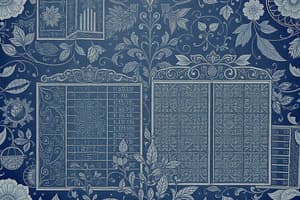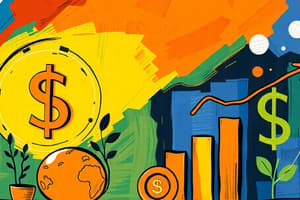Podcast
Questions and Answers
Which type of asset is intended to remain in business for a long time?
Which type of asset is intended to remain in business for a long time?
- Current Assets
- Non-Current Assets (correct)
- Fixed Assets
- Variable Assets
What is the main characteristic of intangible assets?
What is the main characteristic of intangible assets?
- They can be converted into cash easily.
- They do not have physical existence. (correct)
- They have physical existence.
- They are only long-term assets.
Which of the following best describes current liabilities?
Which of the following best describes current liabilities?
- Liabilities expected to be paid within a year. (correct)
- Liabilities that are intangible.
- Liabilities related to fixed assets.
- Liabilities repayable in more than one year.
Which term describes the money owed by a business to others?
Which term describes the money owed by a business to others?
What does working capital refer to?
What does working capital refer to?
Which of the following is considered a non-current liability?
Which of the following is considered a non-current liability?
Which of these is a current asset?
Which of these is a current asset?
What is meant by fixed capital?
What is meant by fixed capital?
What is the primary use of capital receipts in a business?
What is the primary use of capital receipts in a business?
How are revenue receipts generally treated in financial statements?
How are revenue receipts generally treated in financial statements?
Which of the following best defines capital receipts?
Which of the following best defines capital receipts?
What is the main purpose of capital expenditure?
What is the main purpose of capital expenditure?
Which of the following is an example of revenue expenditure?
Which of the following is an example of revenue expenditure?
Which of the following is NOT a characteristic of revenue receipts?
Which of the following is NOT a characteristic of revenue receipts?
How are capital expenditures treated in accounting?
How are capital expenditures treated in accounting?
Accountants match revenue receipts with expenses to determine what metric?
Accountants match revenue receipts with expenses to determine what metric?
Which of the following types of revenue is considered a revenue receipt?
Which of the following types of revenue is considered a revenue receipt?
Which statement best describes revenue expenditure?
Which statement best describes revenue expenditure?
What is a key benefit of accurate accounting treatment of expenditures?
What is a key benefit of accurate accounting treatment of expenditures?
What is a key difference between capital receipts and revenue receipts?
What is a key difference between capital receipts and revenue receipts?
Which of the following is NOT typically a use of revenue receipts?
Which of the following is NOT typically a use of revenue receipts?
Which of the following is NOT a purpose of capital expenditure?
Which of the following is NOT a purpose of capital expenditure?
Which of the following categories does 'insurance premiums' fall under?
Which of the following categories does 'insurance premiums' fall under?
What type of expenditure is primarily intended for short-term operational activities?
What type of expenditure is primarily intended for short-term operational activities?
What is the primary distinction between capital expenditure and revenue expenditure?
What is the primary distinction between capital expenditure and revenue expenditure?
How is capital expenditure categorized in accounting?
How is capital expenditure categorized in accounting?
What happens to renovation costs if they increase the property's value?
What happens to renovation costs if they increase the property's value?
Why are revenue expenditures typically classified as nominal accounts?
Why are revenue expenditures typically classified as nominal accounts?
Which of the following is true regarding the accounting treatment of capital expenditure?
Which of the following is true regarding the accounting treatment of capital expenditure?
Which of the following is an example of how revenue expenditure can become capital expenditure?
Which of the following is an example of how revenue expenditure can become capital expenditure?
What type of expenditure is primarily incurred for the normal conduct of business operations?
What type of expenditure is primarily incurred for the normal conduct of business operations?
How does revenue expenditure influence a business's financial metrics?
How does revenue expenditure influence a business's financial metrics?
Flashcards are hidden until you start studying
Study Notes
Assets
- Assets are tangible or intangible resources used in the business that provide future economic benefits.
- Examples of assets include land, buildings, machinery, and stock.
Types of Assets
- There are two main types of assets: current and non-current.
Non-Current Assets
- These assets are held for long periods and are crucial to the smooth operation of the business
- Examples include land, buildings, machinery, and furniture.
Types of Non-Current Assets
- Tangible Assets have a physical existence, meaning they can be touched and seen.
- Examples include buildings, machinery, and furniture.
- Intangible Assets lack a physical presence and represent a company's value through rights or benefits.
- Examples include goodwill, trademarks, and computer software.
Current Assets
- Current assets are easily converted into cash within a short period.
- Examples include cash in hand, cash at bank, and stock in trade.
Liabilities
- Liabilities represent financial obligations or debts owed to individuals or institutions other than the owner.
- Examples include loans from a bank, bills payable, and creditors.
- Formula: Liabilities = Assets - Capital
Types of Liabilities
- Non-Current or Long-Term Liabilities are payable in more than one year and represent long-term obligations.
- Examples include long-term loans and long-term deposits.
- Current Liabilities are payable within one year and represent short-term obligations.
- Examples include creditors and bank overdrafts.
Capital
- Capital is the total amount invested by the owner in the business, representing the owner's stake.
- Formula: Capital = Total Assets - Liabilities
Types of Capital
- Fixed Capital is used to purchase long-term assets like buildings, plants, and specialized equipment.
- Working Capital is used for the day-to-day operations of the business and ensures smooth cash flow.
- Formula: Working Capital = Current Assets - Current Liabilities
Debtor
- A debtor is an individual or entity that owes money to the business. They represent a current asset for the business.
Creditor
- A creditor is an individual or entity to whom the business owes money. They represent a current liability for the business.
Expenses
- Expenses are the costs incurred by a business during operations, including the use of goods and services to generate revenue.
Capital Expenditure vs Revenue Expenditure
- Capital expenditure (CapEx) is for long-term investments in assets that benefit a business for multiple years.
- Examples of CapEx include purchasing new machinery, building a factory, or upgrading technology.
- CapEx is recorded as an asset on the balance sheet and is depreciated over its useful life.
- Revenue expenditure (RevEx) is incurred for short-term benefits and covers the day-to-day operations of a business.
- RevEx examples include salaries, rent, advertising, and raw materials.
- It is typically recorded as an expense in the income statement.
Capital Receipts vs Revenue Receipts
- Capital receipts involve funds received from long-term investments, asset sales, or debt financing.
- These receipts are considered non-recurring in nature.
- They are shown on the liabilities side of the balance sheet.
- Revenue receipts are obtained from the normal operations of a business, like sales, service fees, or rental income.
- They are recurring in nature.
- Revenue receipts are shown on the income statement.
Key Distinctions Between Capital and Revenue
- Expenditure: CapEx is done for long-term benefits, while RevEx is for short-term operational needs.
- Receipts: CapEx receipts are non-recurring and shown on the balance sheet, while RevEx receipts are recurring and shown on the income statement.
Accounting Treatment of Expenditure
- Capital expenditure is debited to asset accounts and reported on the balance sheet.
- Revenue expenditure is debited to expense accounts and reported on the income statement.
Reasons for Capital Expenditure
- Expand production capacity
- Improve efficiency
- Enhance productivity
- Stay competitive
- Drive growth
Reasons for Revenue Expenditure
- Operate effectively
- Maintain market share
- Support sales and revenue growth
- Cover daily operating expenses
Examples of Revenue Expenditure Becoming Capital Expenditure
- Renovating a rental property that increases its value or extends its useful life.
- Developing software that has a long-term useful life.
- Modifying vehicles in a way that increases value or extends lifespan.
- Creating intellectual property with long-term market value or selling potential.
Studying That Suits You
Use AI to generate personalized quizzes and flashcards to suit your learning preferences.



